Logistics and Supply Chain Management
VerifiedAdded on 2022/10/10
|12
|2275
|240
AI Summary
This document discusses the major subsystems in supply chain, elements of supply chain management, global supply chain management challenges, and business sustainability issues affecting supply chain organizations. It also includes a table of contents, answers to questions, and references. The subject is Logistics and Supply Chain Management, and the course code and college/university are not mentioned. The document type is not mentioned, but it appears to be an essay or assignment.
Contribute Materials
Your contribution can guide someone’s learning journey. Share your
documents today.
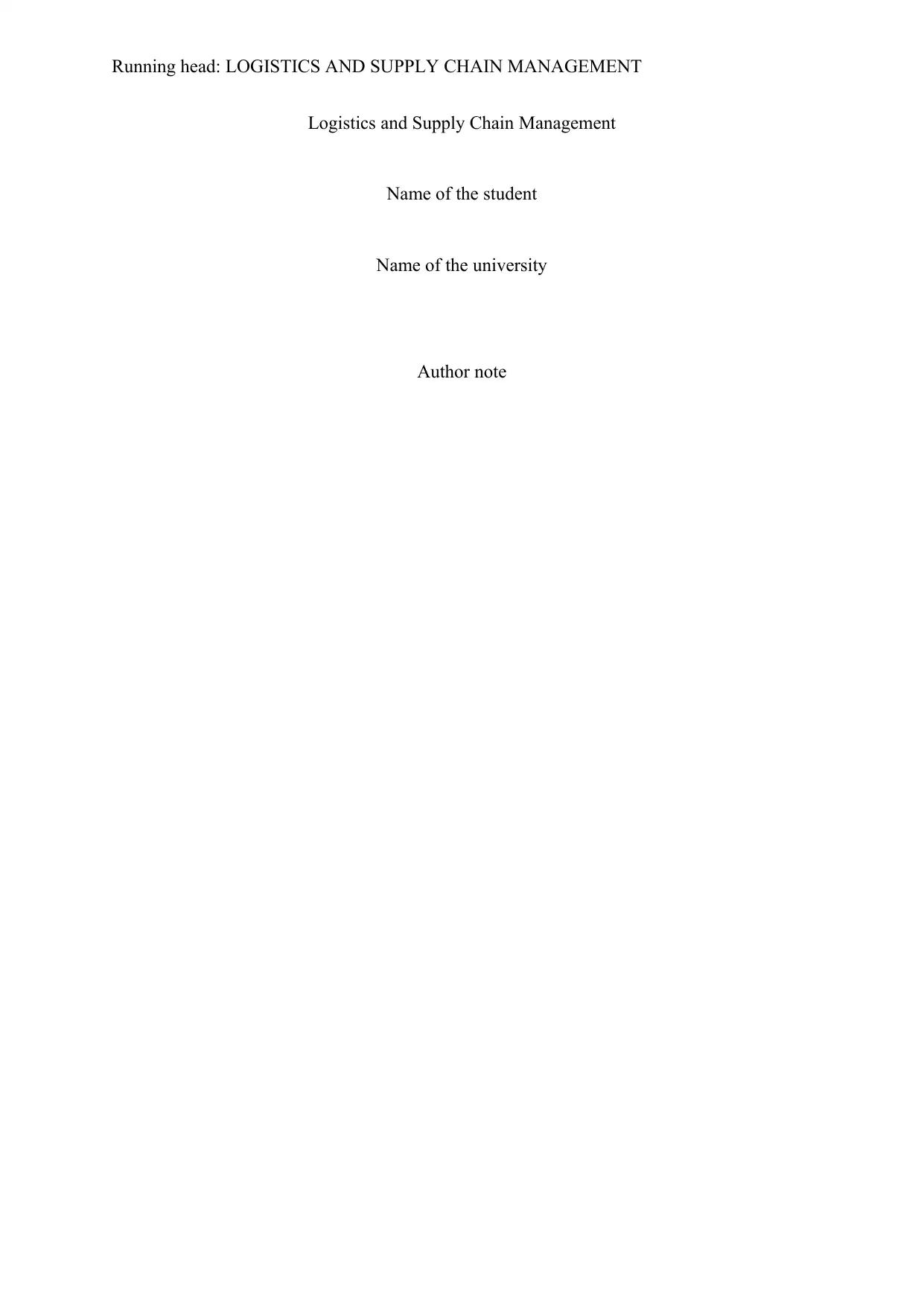
Running head: LOGISTICS AND SUPPLY CHAIN MANAGEMENT
Logistics and Supply Chain Management
Name of the student
Name of the university
Author note
Logistics and Supply Chain Management
Name of the student
Name of the university
Author note
Secure Best Marks with AI Grader
Need help grading? Try our AI Grader for instant feedback on your assignments.
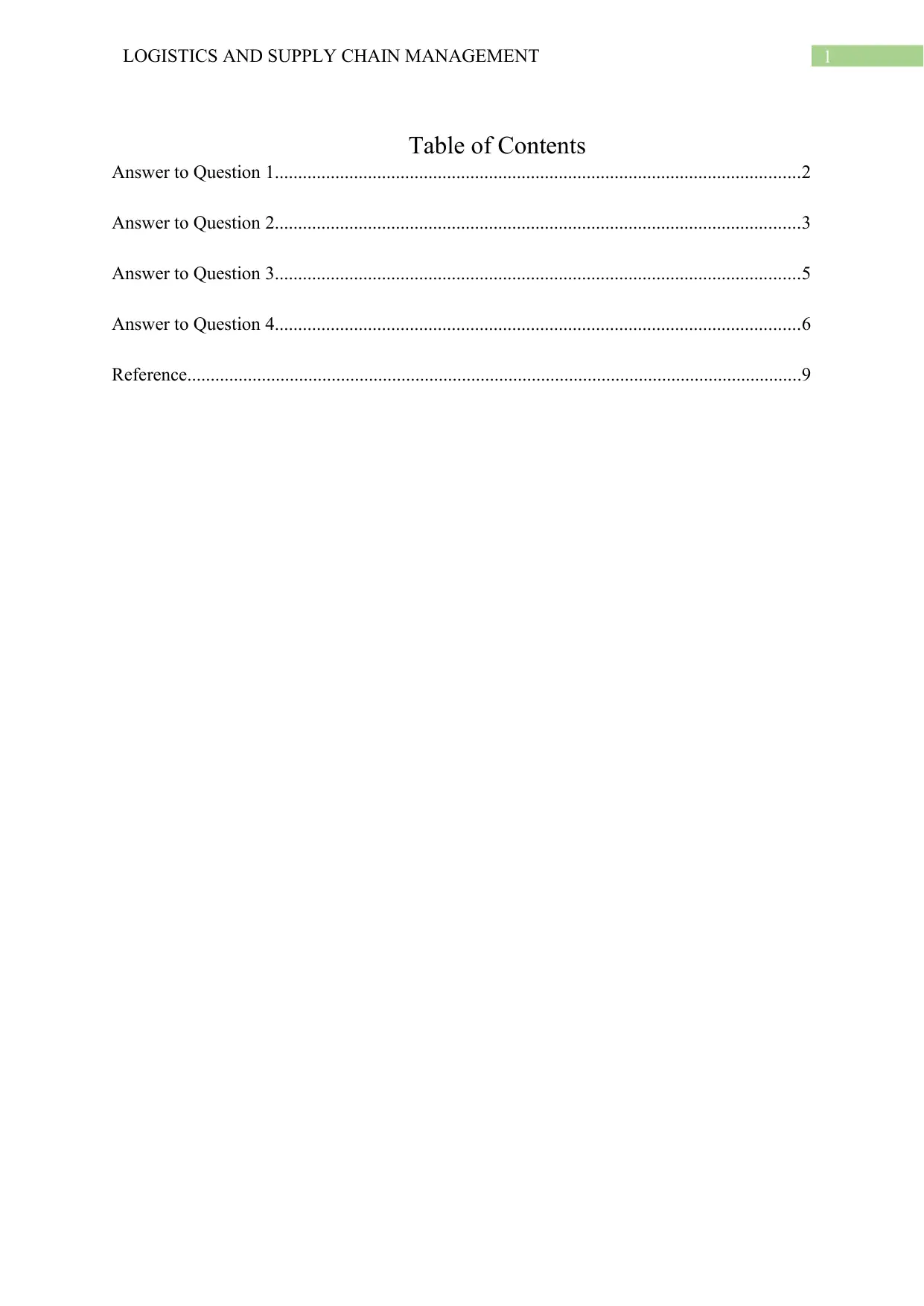
1LOGISTICS AND SUPPLY CHAIN MANAGEMENT
Table of Contents
Answer to Question 1.................................................................................................................2
Answer to Question 2.................................................................................................................3
Answer to Question 3.................................................................................................................5
Answer to Question 4.................................................................................................................6
Reference....................................................................................................................................9
Table of Contents
Answer to Question 1.................................................................................................................2
Answer to Question 2.................................................................................................................3
Answer to Question 3.................................................................................................................5
Answer to Question 4.................................................................................................................6
Reference....................................................................................................................................9
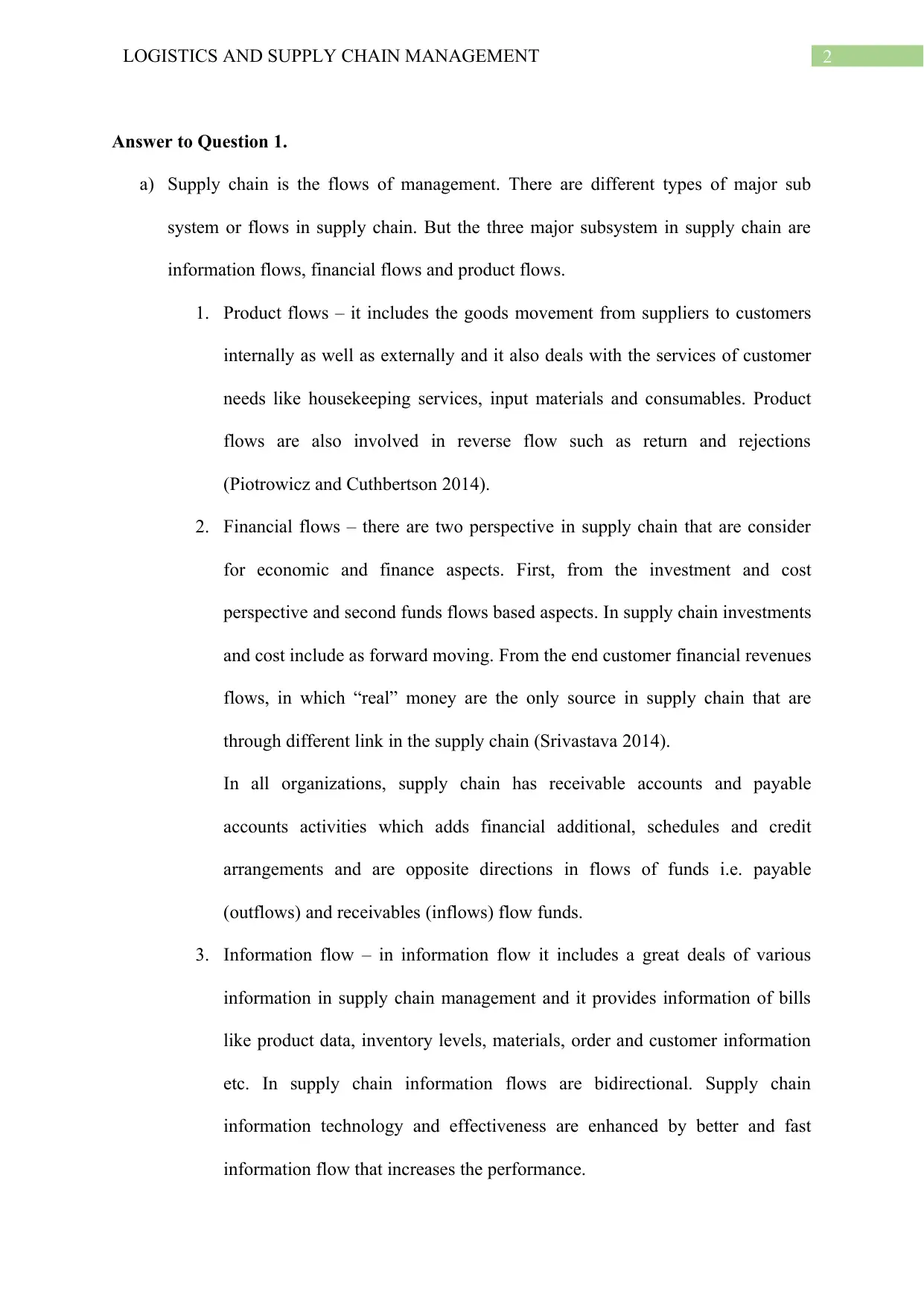
2LOGISTICS AND SUPPLY CHAIN MANAGEMENT
Answer to Question 1.
a) Supply chain is the flows of management. There are different types of major sub
system or flows in supply chain. But the three major subsystem in supply chain are
information flows, financial flows and product flows.
1. Product flows – it includes the goods movement from suppliers to customers
internally as well as externally and it also deals with the services of customer
needs like housekeeping services, input materials and consumables. Product
flows are also involved in reverse flow such as return and rejections
(Piotrowicz and Cuthbertson 2014).
2. Financial flows – there are two perspective in supply chain that are consider
for economic and finance aspects. First, from the investment and cost
perspective and second funds flows based aspects. In supply chain investments
and cost include as forward moving. From the end customer financial revenues
flows, in which “real” money are the only source in supply chain that are
through different link in the supply chain (Srivastava 2014).
In all organizations, supply chain has receivable accounts and payable
accounts activities which adds financial additional, schedules and credit
arrangements and are opposite directions in flows of funds i.e. payable
(outflows) and receivables (inflows) flow funds.
3. Information flow – in information flow it includes a great deals of various
information in supply chain management and it provides information of bills
like product data, inventory levels, materials, order and customer information
etc. In supply chain information flows are bidirectional. Supply chain
information technology and effectiveness are enhanced by better and fast
information flow that increases the performance.
Answer to Question 1.
a) Supply chain is the flows of management. There are different types of major sub
system or flows in supply chain. But the three major subsystem in supply chain are
information flows, financial flows and product flows.
1. Product flows – it includes the goods movement from suppliers to customers
internally as well as externally and it also deals with the services of customer
needs like housekeeping services, input materials and consumables. Product
flows are also involved in reverse flow such as return and rejections
(Piotrowicz and Cuthbertson 2014).
2. Financial flows – there are two perspective in supply chain that are consider
for economic and finance aspects. First, from the investment and cost
perspective and second funds flows based aspects. In supply chain investments
and cost include as forward moving. From the end customer financial revenues
flows, in which “real” money are the only source in supply chain that are
through different link in the supply chain (Srivastava 2014).
In all organizations, supply chain has receivable accounts and payable
accounts activities which adds financial additional, schedules and credit
arrangements and are opposite directions in flows of funds i.e. payable
(outflows) and receivables (inflows) flow funds.
3. Information flow – in information flow it includes a great deals of various
information in supply chain management and it provides information of bills
like product data, inventory levels, materials, order and customer information
etc. In supply chain information flows are bidirectional. Supply chain
information technology and effectiveness are enhanced by better and fast
information flow that increases the performance.
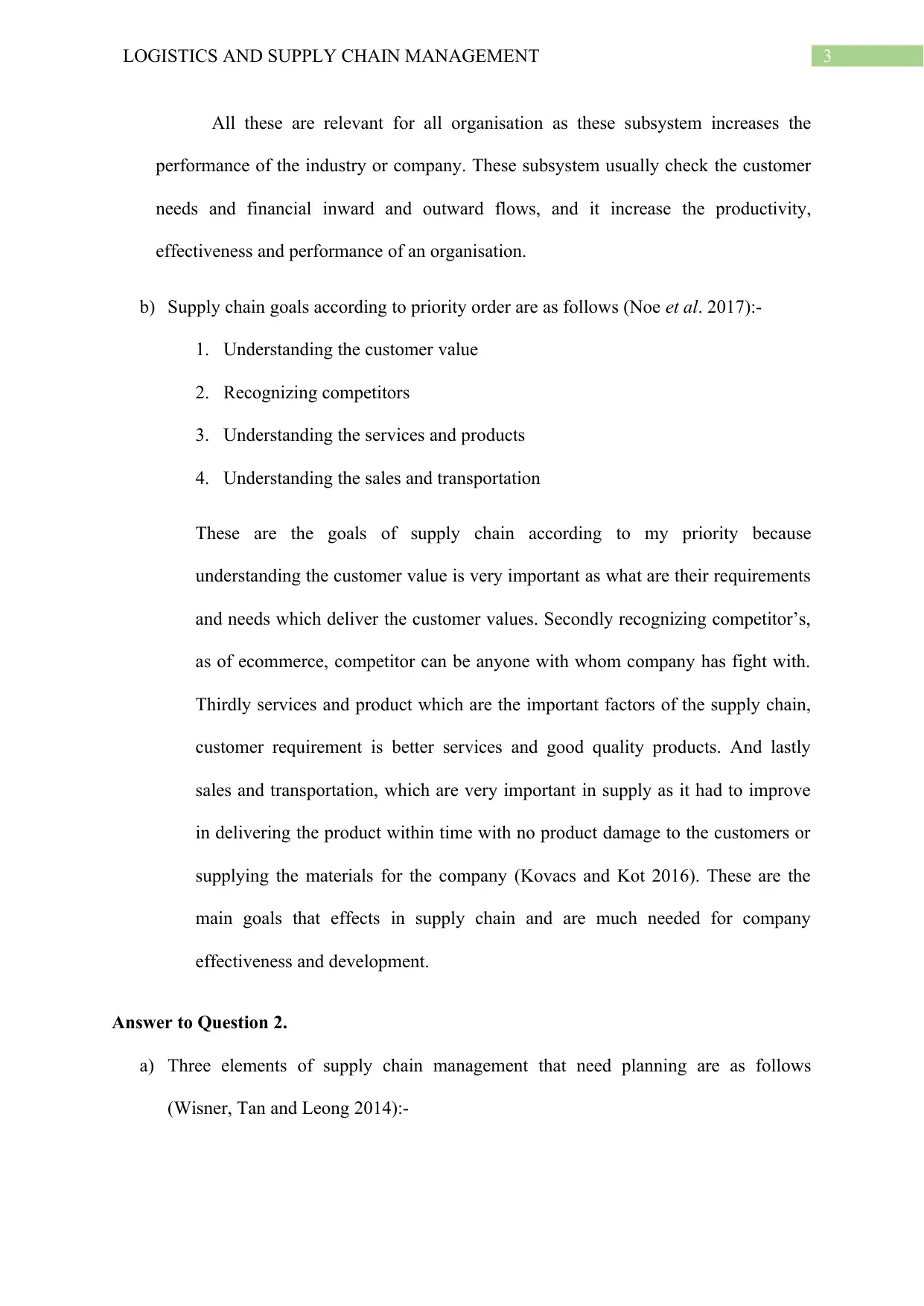
3LOGISTICS AND SUPPLY CHAIN MANAGEMENT
All these are relevant for all organisation as these subsystem increases the
performance of the industry or company. These subsystem usually check the customer
needs and financial inward and outward flows, and it increase the productivity,
effectiveness and performance of an organisation.
b) Supply chain goals according to priority order are as follows (Noe et al. 2017):-
1. Understanding the customer value
2. Recognizing competitors
3. Understanding the services and products
4. Understanding the sales and transportation
These are the goals of supply chain according to my priority because
understanding the customer value is very important as what are their requirements
and needs which deliver the customer values. Secondly recognizing competitor’s,
as of ecommerce, competitor can be anyone with whom company has fight with.
Thirdly services and product which are the important factors of the supply chain,
customer requirement is better services and good quality products. And lastly
sales and transportation, which are very important in supply as it had to improve
in delivering the product within time with no product damage to the customers or
supplying the materials for the company (Kovacs and Kot 2016). These are the
main goals that effects in supply chain and are much needed for company
effectiveness and development.
Answer to Question 2.
a) Three elements of supply chain management that need planning are as follows
(Wisner, Tan and Leong 2014):-
All these are relevant for all organisation as these subsystem increases the
performance of the industry or company. These subsystem usually check the customer
needs and financial inward and outward flows, and it increase the productivity,
effectiveness and performance of an organisation.
b) Supply chain goals according to priority order are as follows (Noe et al. 2017):-
1. Understanding the customer value
2. Recognizing competitors
3. Understanding the services and products
4. Understanding the sales and transportation
These are the goals of supply chain according to my priority because
understanding the customer value is very important as what are their requirements
and needs which deliver the customer values. Secondly recognizing competitor’s,
as of ecommerce, competitor can be anyone with whom company has fight with.
Thirdly services and product which are the important factors of the supply chain,
customer requirement is better services and good quality products. And lastly
sales and transportation, which are very important in supply as it had to improve
in delivering the product within time with no product damage to the customers or
supplying the materials for the company (Kovacs and Kot 2016). These are the
main goals that effects in supply chain and are much needed for company
effectiveness and development.
Answer to Question 2.
a) Three elements of supply chain management that need planning are as follows
(Wisner, Tan and Leong 2014):-
Secure Best Marks with AI Grader
Need help grading? Try our AI Grader for instant feedback on your assignments.
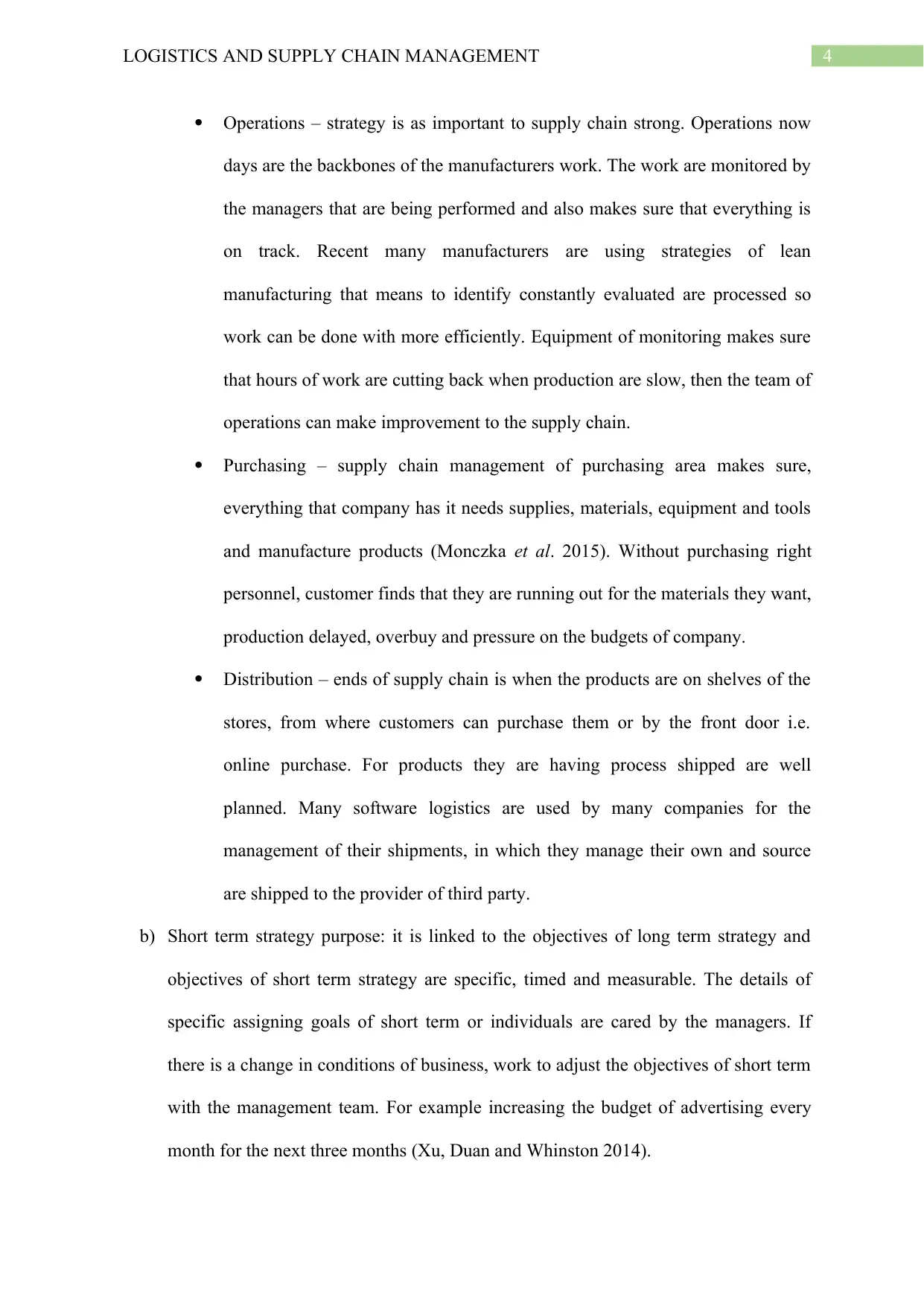
4LOGISTICS AND SUPPLY CHAIN MANAGEMENT
Operations – strategy is as important to supply chain strong. Operations now
days are the backbones of the manufacturers work. The work are monitored by
the managers that are being performed and also makes sure that everything is
on track. Recent many manufacturers are using strategies of lean
manufacturing that means to identify constantly evaluated are processed so
work can be done with more efficiently. Equipment of monitoring makes sure
that hours of work are cutting back when production are slow, then the team of
operations can make improvement to the supply chain.
Purchasing – supply chain management of purchasing area makes sure,
everything that company has it needs supplies, materials, equipment and tools
and manufacture products (Monczka et al. 2015). Without purchasing right
personnel, customer finds that they are running out for the materials they want,
production delayed, overbuy and pressure on the budgets of company.
Distribution – ends of supply chain is when the products are on shelves of the
stores, from where customers can purchase them or by the front door i.e.
online purchase. For products they are having process shipped are well
planned. Many software logistics are used by many companies for the
management of their shipments, in which they manage their own and source
are shipped to the provider of third party.
b) Short term strategy purpose: it is linked to the objectives of long term strategy and
objectives of short term strategy are specific, timed and measurable. The details of
specific assigning goals of short term or individuals are cared by the managers. If
there is a change in conditions of business, work to adjust the objectives of short term
with the management team. For example increasing the budget of advertising every
month for the next three months (Xu, Duan and Whinston 2014).
Operations – strategy is as important to supply chain strong. Operations now
days are the backbones of the manufacturers work. The work are monitored by
the managers that are being performed and also makes sure that everything is
on track. Recent many manufacturers are using strategies of lean
manufacturing that means to identify constantly evaluated are processed so
work can be done with more efficiently. Equipment of monitoring makes sure
that hours of work are cutting back when production are slow, then the team of
operations can make improvement to the supply chain.
Purchasing – supply chain management of purchasing area makes sure,
everything that company has it needs supplies, materials, equipment and tools
and manufacture products (Monczka et al. 2015). Without purchasing right
personnel, customer finds that they are running out for the materials they want,
production delayed, overbuy and pressure on the budgets of company.
Distribution – ends of supply chain is when the products are on shelves of the
stores, from where customers can purchase them or by the front door i.e.
online purchase. For products they are having process shipped are well
planned. Many software logistics are used by many companies for the
management of their shipments, in which they manage their own and source
are shipped to the provider of third party.
b) Short term strategy purpose: it is linked to the objectives of long term strategy and
objectives of short term strategy are specific, timed and measurable. The details of
specific assigning goals of short term or individuals are cared by the managers. If
there is a change in conditions of business, work to adjust the objectives of short term
with the management team. For example increasing the budget of advertising every
month for the next three months (Xu, Duan and Whinston 2014).
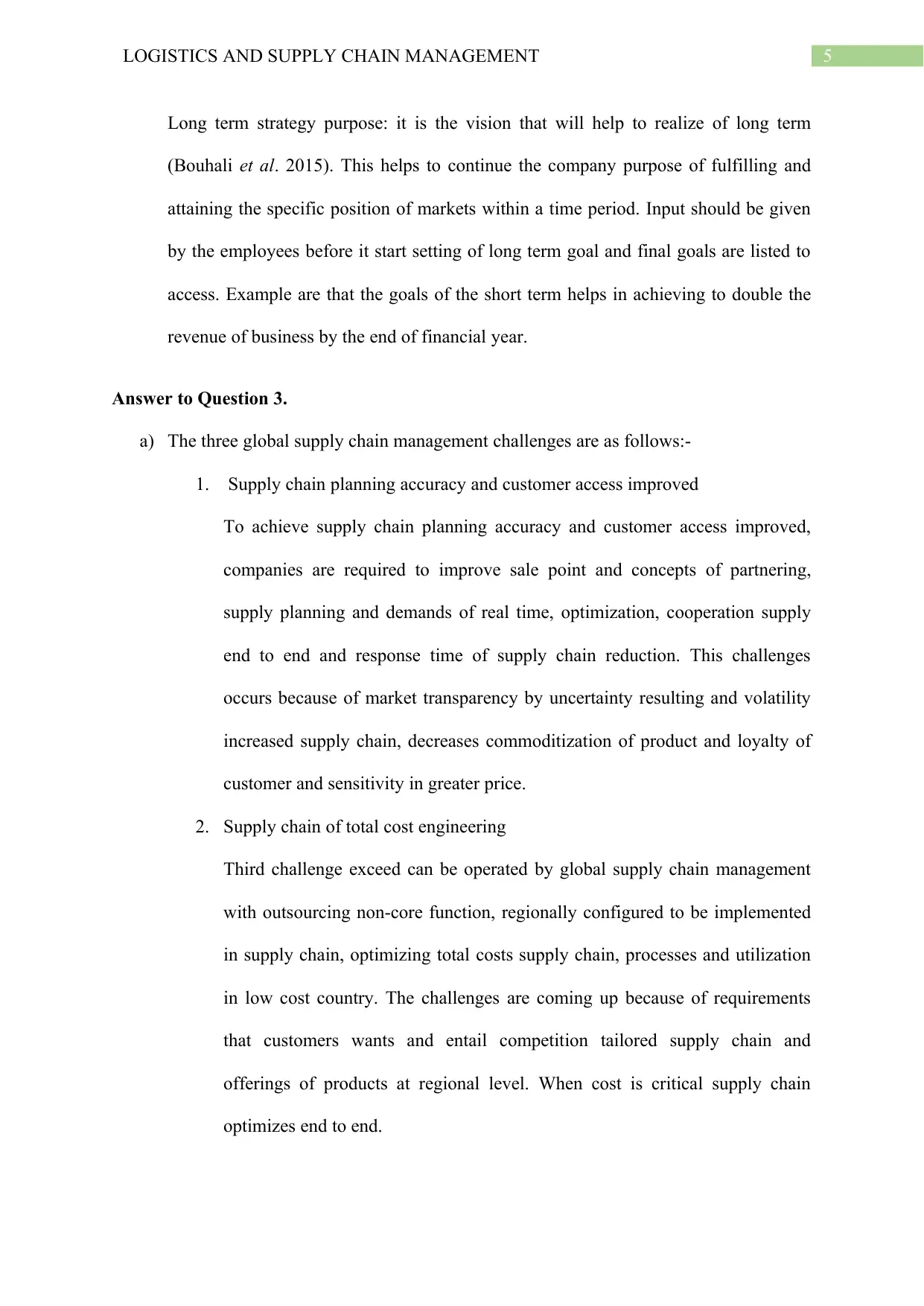
5LOGISTICS AND SUPPLY CHAIN MANAGEMENT
Long term strategy purpose: it is the vision that will help to realize of long term
(Bouhali et al. 2015). This helps to continue the company purpose of fulfilling and
attaining the specific position of markets within a time period. Input should be given
by the employees before it start setting of long term goal and final goals are listed to
access. Example are that the goals of the short term helps in achieving to double the
revenue of business by the end of financial year.
Answer to Question 3.
a) The three global supply chain management challenges are as follows:-
1. Supply chain planning accuracy and customer access improved
To achieve supply chain planning accuracy and customer access improved,
companies are required to improve sale point and concepts of partnering,
supply planning and demands of real time, optimization, cooperation supply
end to end and response time of supply chain reduction. This challenges
occurs because of market transparency by uncertainty resulting and volatility
increased supply chain, decreases commoditization of product and loyalty of
customer and sensitivity in greater price.
2. Supply chain of total cost engineering
Third challenge exceed can be operated by global supply chain management
with outsourcing non-core function, regionally configured to be implemented
in supply chain, optimizing total costs supply chain, processes and utilization
in low cost country. The challenges are coming up because of requirements
that customers wants and entail competition tailored supply chain and
offerings of products at regional level. When cost is critical supply chain
optimizes end to end.
Long term strategy purpose: it is the vision that will help to realize of long term
(Bouhali et al. 2015). This helps to continue the company purpose of fulfilling and
attaining the specific position of markets within a time period. Input should be given
by the employees before it start setting of long term goal and final goals are listed to
access. Example are that the goals of the short term helps in achieving to double the
revenue of business by the end of financial year.
Answer to Question 3.
a) The three global supply chain management challenges are as follows:-
1. Supply chain planning accuracy and customer access improved
To achieve supply chain planning accuracy and customer access improved,
companies are required to improve sale point and concepts of partnering,
supply planning and demands of real time, optimization, cooperation supply
end to end and response time of supply chain reduction. This challenges
occurs because of market transparency by uncertainty resulting and volatility
increased supply chain, decreases commoditization of product and loyalty of
customer and sensitivity in greater price.
2. Supply chain of total cost engineering
Third challenge exceed can be operated by global supply chain management
with outsourcing non-core function, regionally configured to be implemented
in supply chain, optimizing total costs supply chain, processes and utilization
in low cost country. The challenges are coming up because of requirements
that customers wants and entail competition tailored supply chain and
offerings of products at regional level. When cost is critical supply chain
optimizes end to end.
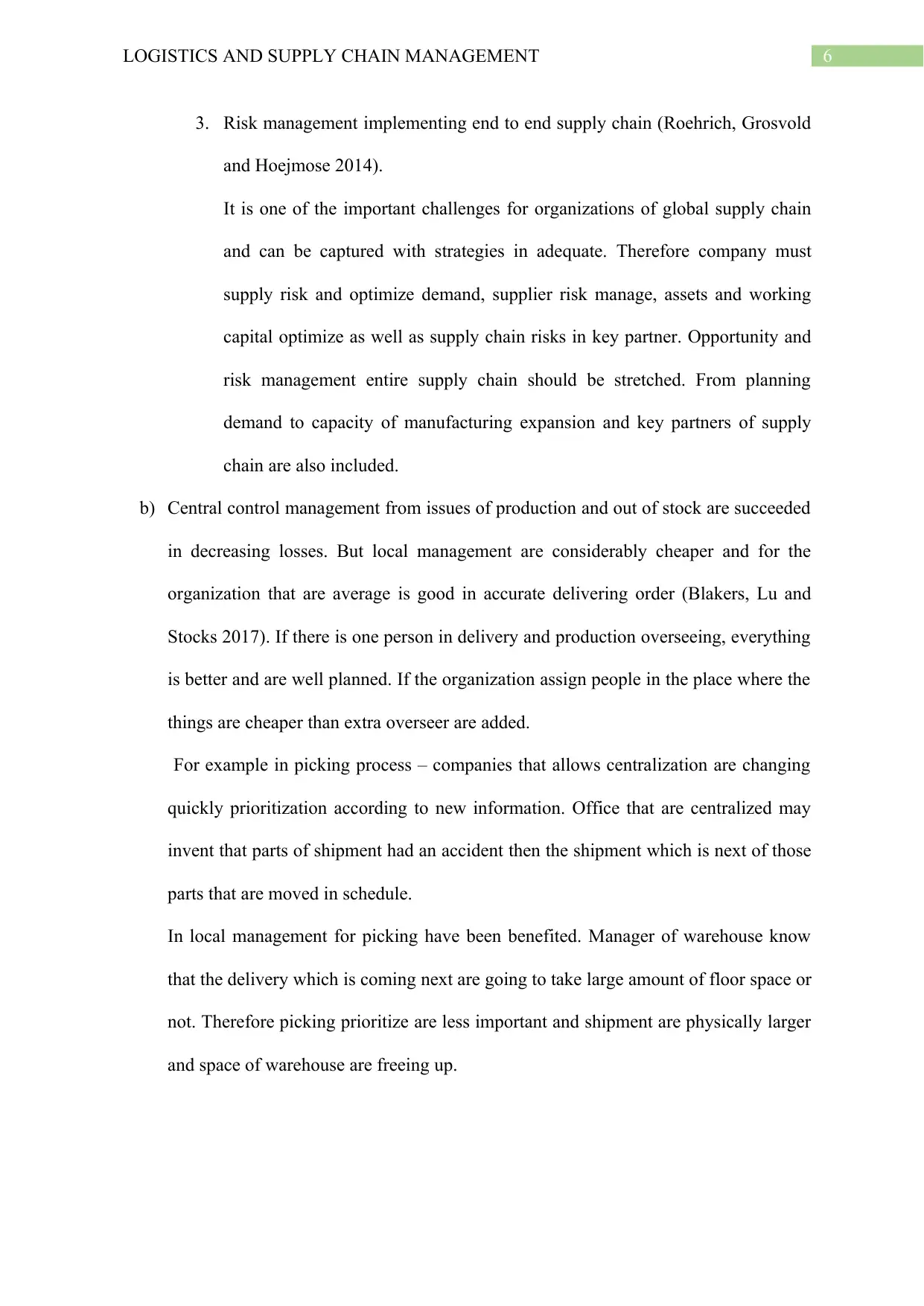
6LOGISTICS AND SUPPLY CHAIN MANAGEMENT
3. Risk management implementing end to end supply chain (Roehrich, Grosvold
and Hoejmose 2014).
It is one of the important challenges for organizations of global supply chain
and can be captured with strategies in adequate. Therefore company must
supply risk and optimize demand, supplier risk manage, assets and working
capital optimize as well as supply chain risks in key partner. Opportunity and
risk management entire supply chain should be stretched. From planning
demand to capacity of manufacturing expansion and key partners of supply
chain are also included.
b) Central control management from issues of production and out of stock are succeeded
in decreasing losses. But local management are considerably cheaper and for the
organization that are average is good in accurate delivering order (Blakers, Lu and
Stocks 2017). If there is one person in delivery and production overseeing, everything
is better and are well planned. If the organization assign people in the place where the
things are cheaper than extra overseer are added.
For example in picking process – companies that allows centralization are changing
quickly prioritization according to new information. Office that are centralized may
invent that parts of shipment had an accident then the shipment which is next of those
parts that are moved in schedule.
In local management for picking have been benefited. Manager of warehouse know
that the delivery which is coming next are going to take large amount of floor space or
not. Therefore picking prioritize are less important and shipment are physically larger
and space of warehouse are freeing up.
3. Risk management implementing end to end supply chain (Roehrich, Grosvold
and Hoejmose 2014).
It is one of the important challenges for organizations of global supply chain
and can be captured with strategies in adequate. Therefore company must
supply risk and optimize demand, supplier risk manage, assets and working
capital optimize as well as supply chain risks in key partner. Opportunity and
risk management entire supply chain should be stretched. From planning
demand to capacity of manufacturing expansion and key partners of supply
chain are also included.
b) Central control management from issues of production and out of stock are succeeded
in decreasing losses. But local management are considerably cheaper and for the
organization that are average is good in accurate delivering order (Blakers, Lu and
Stocks 2017). If there is one person in delivery and production overseeing, everything
is better and are well planned. If the organization assign people in the place where the
things are cheaper than extra overseer are added.
For example in picking process – companies that allows centralization are changing
quickly prioritization according to new information. Office that are centralized may
invent that parts of shipment had an accident then the shipment which is next of those
parts that are moved in schedule.
In local management for picking have been benefited. Manager of warehouse know
that the delivery which is coming next are going to take large amount of floor space or
not. Therefore picking prioritize are less important and shipment are physically larger
and space of warehouse are freeing up.
Paraphrase This Document
Need a fresh take? Get an instant paraphrase of this document with our AI Paraphraser
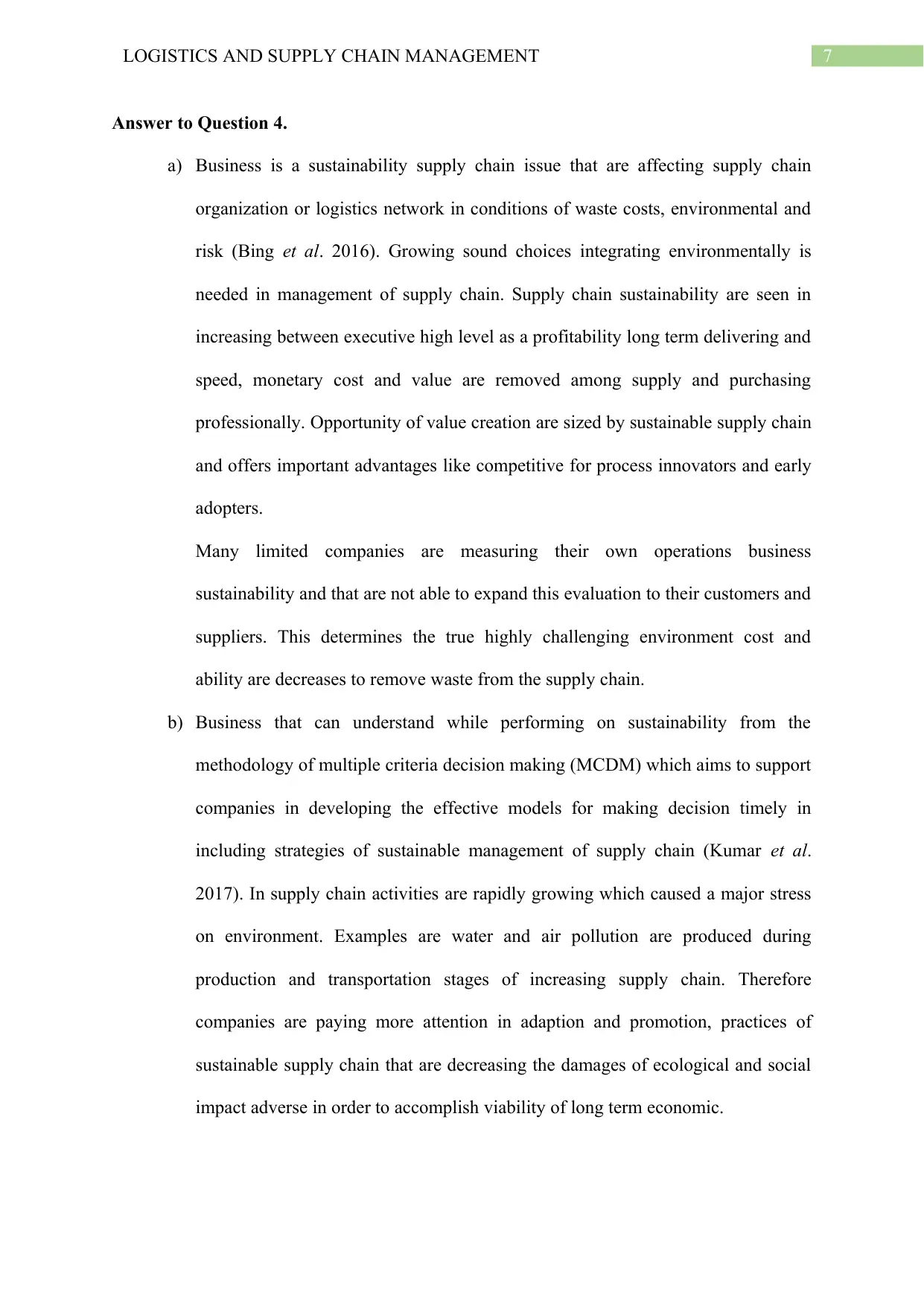
7LOGISTICS AND SUPPLY CHAIN MANAGEMENT
Answer to Question 4.
a) Business is a sustainability supply chain issue that are affecting supply chain
organization or logistics network in conditions of waste costs, environmental and
risk (Bing et al. 2016). Growing sound choices integrating environmentally is
needed in management of supply chain. Supply chain sustainability are seen in
increasing between executive high level as a profitability long term delivering and
speed, monetary cost and value are removed among supply and purchasing
professionally. Opportunity of value creation are sized by sustainable supply chain
and offers important advantages like competitive for process innovators and early
adopters.
Many limited companies are measuring their own operations business
sustainability and that are not able to expand this evaluation to their customers and
suppliers. This determines the true highly challenging environment cost and
ability are decreases to remove waste from the supply chain.
b) Business that can understand while performing on sustainability from the
methodology of multiple criteria decision making (MCDM) which aims to support
companies in developing the effective models for making decision timely in
including strategies of sustainable management of supply chain (Kumar et al.
2017). In supply chain activities are rapidly growing which caused a major stress
on environment. Examples are water and air pollution are produced during
production and transportation stages of increasing supply chain. Therefore
companies are paying more attention in adaption and promotion, practices of
sustainable supply chain that are decreasing the damages of ecological and social
impact adverse in order to accomplish viability of long term economic.
Answer to Question 4.
a) Business is a sustainability supply chain issue that are affecting supply chain
organization or logistics network in conditions of waste costs, environmental and
risk (Bing et al. 2016). Growing sound choices integrating environmentally is
needed in management of supply chain. Supply chain sustainability are seen in
increasing between executive high level as a profitability long term delivering and
speed, monetary cost and value are removed among supply and purchasing
professionally. Opportunity of value creation are sized by sustainable supply chain
and offers important advantages like competitive for process innovators and early
adopters.
Many limited companies are measuring their own operations business
sustainability and that are not able to expand this evaluation to their customers and
suppliers. This determines the true highly challenging environment cost and
ability are decreases to remove waste from the supply chain.
b) Business that can understand while performing on sustainability from the
methodology of multiple criteria decision making (MCDM) which aims to support
companies in developing the effective models for making decision timely in
including strategies of sustainable management of supply chain (Kumar et al.
2017). In supply chain activities are rapidly growing which caused a major stress
on environment. Examples are water and air pollution are produced during
production and transportation stages of increasing supply chain. Therefore
companies are paying more attention in adaption and promotion, practices of
sustainable supply chain that are decreasing the damages of ecological and social
impact adverse in order to accomplish viability of long term economic.
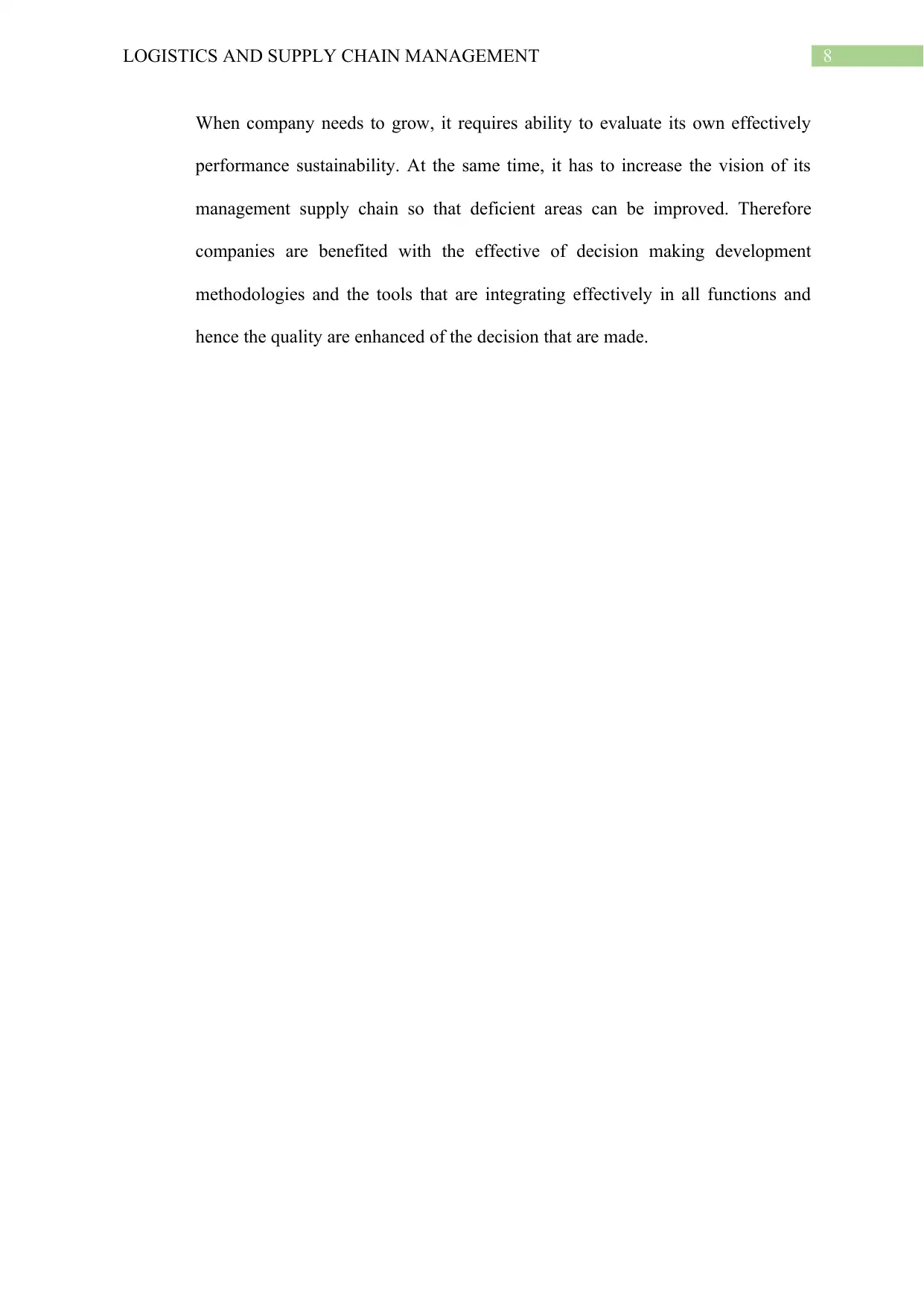
8LOGISTICS AND SUPPLY CHAIN MANAGEMENT
When company needs to grow, it requires ability to evaluate its own effectively
performance sustainability. At the same time, it has to increase the vision of its
management supply chain so that deficient areas can be improved. Therefore
companies are benefited with the effective of decision making development
methodologies and the tools that are integrating effectively in all functions and
hence the quality are enhanced of the decision that are made.
When company needs to grow, it requires ability to evaluate its own effectively
performance sustainability. At the same time, it has to increase the vision of its
management supply chain so that deficient areas can be improved. Therefore
companies are benefited with the effective of decision making development
methodologies and the tools that are integrating effectively in all functions and
hence the quality are enhanced of the decision that are made.
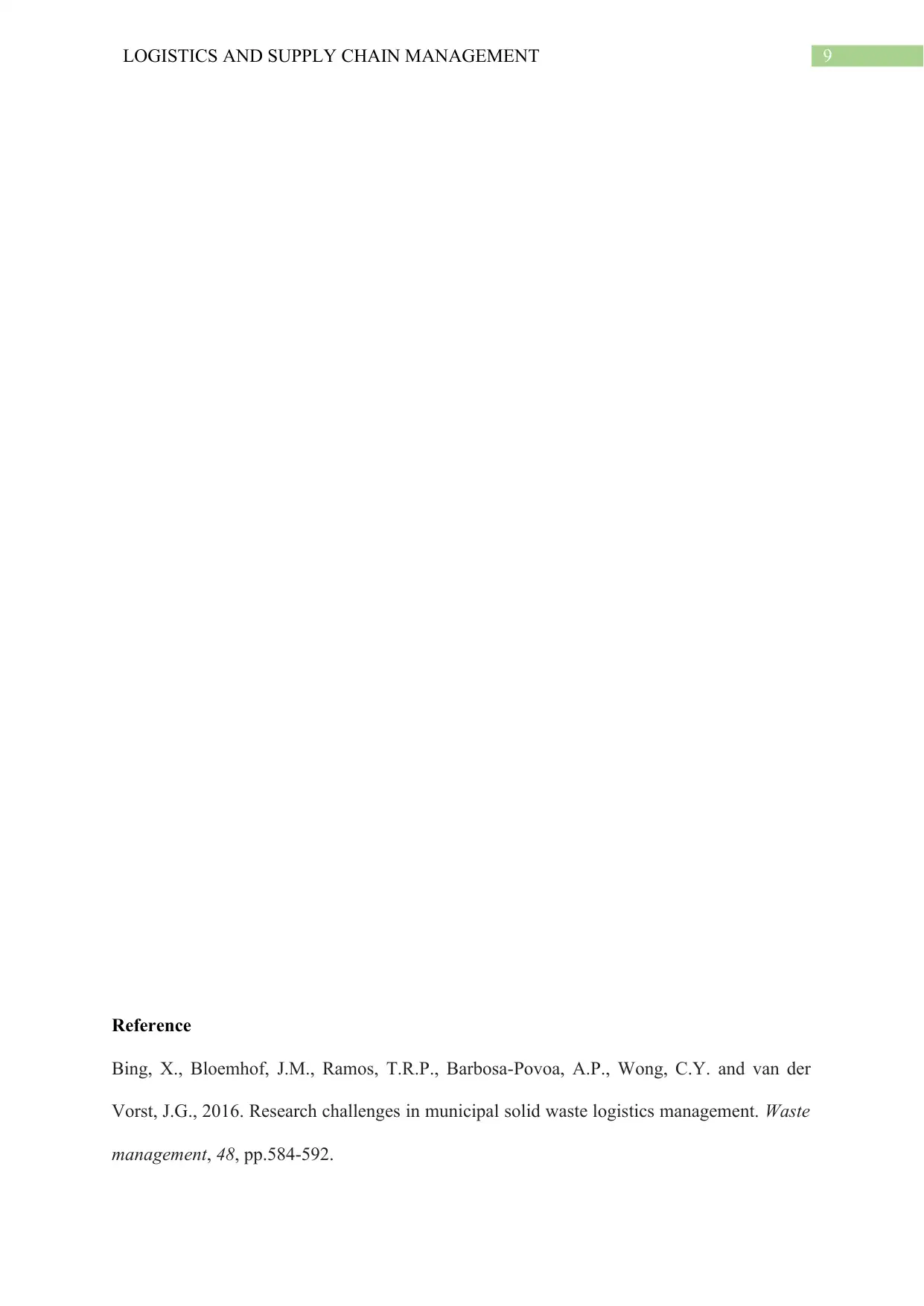
9LOGISTICS AND SUPPLY CHAIN MANAGEMENT
Reference
Bing, X., Bloemhof, J.M., Ramos, T.R.P., Barbosa-Povoa, A.P., Wong, C.Y. and van der
Vorst, J.G., 2016. Research challenges in municipal solid waste logistics management. Waste
management, 48, pp.584-592.
Reference
Bing, X., Bloemhof, J.M., Ramos, T.R.P., Barbosa-Povoa, A.P., Wong, C.Y. and van der
Vorst, J.G., 2016. Research challenges in municipal solid waste logistics management. Waste
management, 48, pp.584-592.
Secure Best Marks with AI Grader
Need help grading? Try our AI Grader for instant feedback on your assignments.
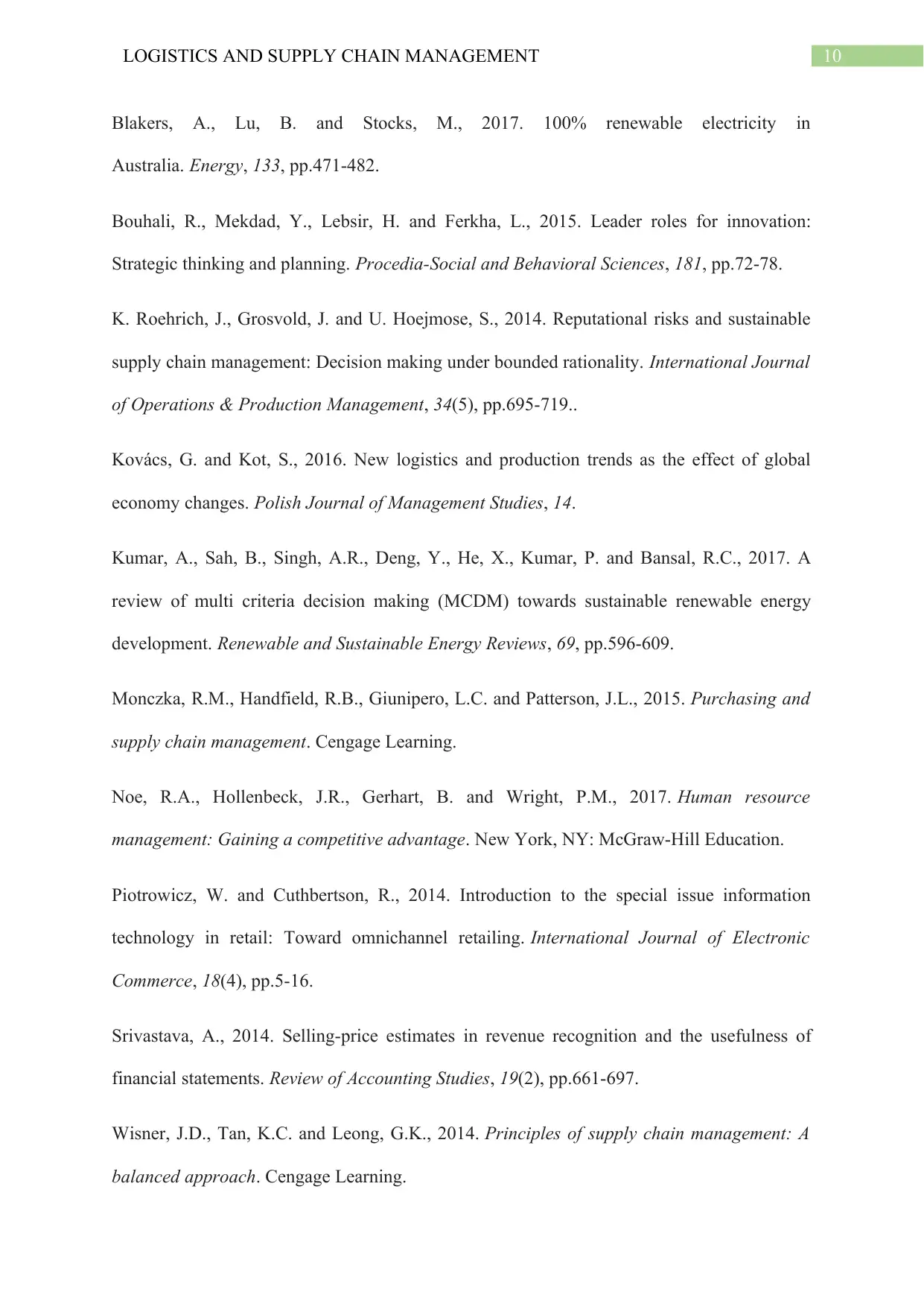
10LOGISTICS AND SUPPLY CHAIN MANAGEMENT
Blakers, A., Lu, B. and Stocks, M., 2017. 100% renewable electricity in
Australia. Energy, 133, pp.471-482.
Bouhali, R., Mekdad, Y., Lebsir, H. and Ferkha, L., 2015. Leader roles for innovation:
Strategic thinking and planning. Procedia-Social and Behavioral Sciences, 181, pp.72-78.
K. Roehrich, J., Grosvold, J. and U. Hoejmose, S., 2014. Reputational risks and sustainable
supply chain management: Decision making under bounded rationality. International Journal
of Operations & Production Management, 34(5), pp.695-719..
Kovács, G. and Kot, S., 2016. New logistics and production trends as the effect of global
economy changes. Polish Journal of Management Studies, 14.
Kumar, A., Sah, B., Singh, A.R., Deng, Y., He, X., Kumar, P. and Bansal, R.C., 2017. A
review of multi criteria decision making (MCDM) towards sustainable renewable energy
development. Renewable and Sustainable Energy Reviews, 69, pp.596-609.
Monczka, R.M., Handfield, R.B., Giunipero, L.C. and Patterson, J.L., 2015. Purchasing and
supply chain management. Cengage Learning.
Noe, R.A., Hollenbeck, J.R., Gerhart, B. and Wright, P.M., 2017. Human resource
management: Gaining a competitive advantage. New York, NY: McGraw-Hill Education.
Piotrowicz, W. and Cuthbertson, R., 2014. Introduction to the special issue information
technology in retail: Toward omnichannel retailing. International Journal of Electronic
Commerce, 18(4), pp.5-16.
Srivastava, A., 2014. Selling-price estimates in revenue recognition and the usefulness of
financial statements. Review of Accounting Studies, 19(2), pp.661-697.
Wisner, J.D., Tan, K.C. and Leong, G.K., 2014. Principles of supply chain management: A
balanced approach. Cengage Learning.
Blakers, A., Lu, B. and Stocks, M., 2017. 100% renewable electricity in
Australia. Energy, 133, pp.471-482.
Bouhali, R., Mekdad, Y., Lebsir, H. and Ferkha, L., 2015. Leader roles for innovation:
Strategic thinking and planning. Procedia-Social and Behavioral Sciences, 181, pp.72-78.
K. Roehrich, J., Grosvold, J. and U. Hoejmose, S., 2014. Reputational risks and sustainable
supply chain management: Decision making under bounded rationality. International Journal
of Operations & Production Management, 34(5), pp.695-719..
Kovács, G. and Kot, S., 2016. New logistics and production trends as the effect of global
economy changes. Polish Journal of Management Studies, 14.
Kumar, A., Sah, B., Singh, A.R., Deng, Y., He, X., Kumar, P. and Bansal, R.C., 2017. A
review of multi criteria decision making (MCDM) towards sustainable renewable energy
development. Renewable and Sustainable Energy Reviews, 69, pp.596-609.
Monczka, R.M., Handfield, R.B., Giunipero, L.C. and Patterson, J.L., 2015. Purchasing and
supply chain management. Cengage Learning.
Noe, R.A., Hollenbeck, J.R., Gerhart, B. and Wright, P.M., 2017. Human resource
management: Gaining a competitive advantage. New York, NY: McGraw-Hill Education.
Piotrowicz, W. and Cuthbertson, R., 2014. Introduction to the special issue information
technology in retail: Toward omnichannel retailing. International Journal of Electronic
Commerce, 18(4), pp.5-16.
Srivastava, A., 2014. Selling-price estimates in revenue recognition and the usefulness of
financial statements. Review of Accounting Studies, 19(2), pp.661-697.
Wisner, J.D., Tan, K.C. and Leong, G.K., 2014. Principles of supply chain management: A
balanced approach. Cengage Learning.
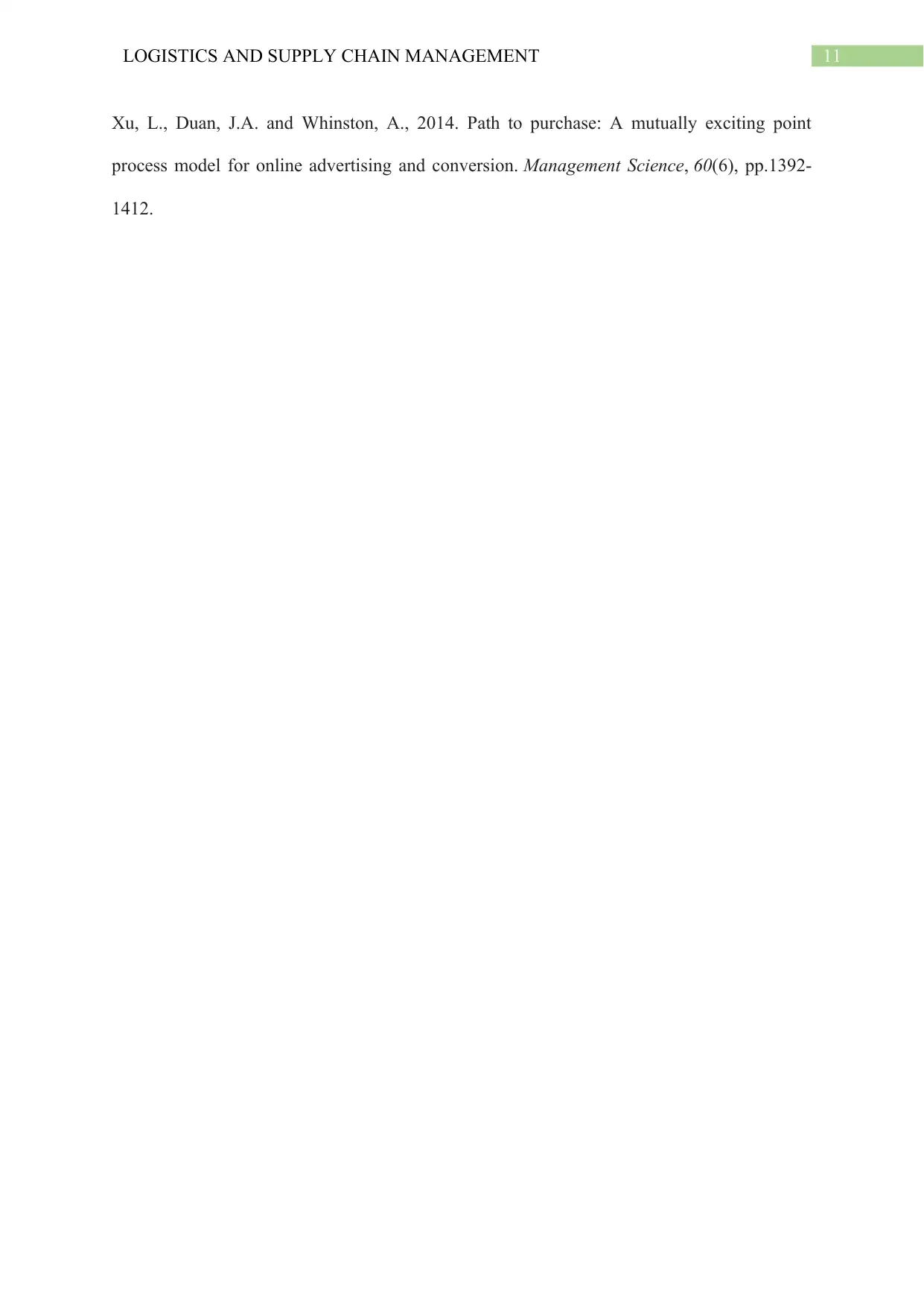
11LOGISTICS AND SUPPLY CHAIN MANAGEMENT
Xu, L., Duan, J.A. and Whinston, A., 2014. Path to purchase: A mutually exciting point
process model for online advertising and conversion. Management Science, 60(6), pp.1392-
1412.
Xu, L., Duan, J.A. and Whinston, A., 2014. Path to purchase: A mutually exciting point
process model for online advertising and conversion. Management Science, 60(6), pp.1392-
1412.
1 out of 12
Related Documents
Your All-in-One AI-Powered Toolkit for Academic Success.
+13062052269
info@desklib.com
Available 24*7 on WhatsApp / Email
![[object Object]](/_next/static/media/star-bottom.7253800d.svg)
Unlock your academic potential
© 2024 | Zucol Services PVT LTD | All rights reserved.





